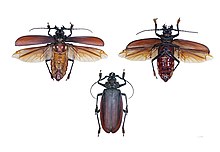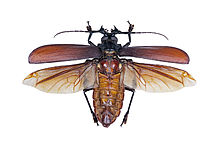Titan beetle
| Titan beetle | |
|---|---|

| |
| Titanus giganteus | |
| Scientific classification | |
| Domain: | Eukaryota |
| Kingdom: | Animalia |
| Phylum: | Arthropoda |
| Class: | Insecta |
| Order: | Coleoptera |
| Infraorder: | Cucujiformia |
| Family: | Cerambycidae |
| Subfamily: | Prioninae |
| Tribe: | Prionini |
| Genus: | Titanus Audinet-Serville, 1832 |
| Species: | T. giganteus
|
| Binomial name | |
| Titanus giganteus (Linnaeus, 1771)
| |
| Synonyms | |
|
(Genus)
(Species)
| |
The titan beetle (Titanus giganteus) is a Neotropical longhorn beetle, the sole species in the genus Titanus, and one of the largest known beetles, as well as one of the largest known insects in the world.
Titan beetles are part of the
Diet
Even though the Cerambycidae family is known to utilize a plant diet for sustenance, the Priorinae subfamily does not accept any food with the exception of water. Reflected in their anatomy, titan beetles do not have all the digestive enzymes and fat reserves needed to consume food on a daily basis. Rather when the titan beetles are larvae, they ingest dead wood and plants infested by fungi.[2] This initial caloric intake is meant to last the lifetime of the beetle. Their dietary habits as larvae contribute to the recycling of dead plants in the ecosystem, converting decayed matter into humus.
The subfamily Priorinae of titan beetles are known as gall-inducing insects. Galls, which are abnormal growths in plants, are a byproduct of plant consumption. These galls are used as nests for many insects, including beetles.[3]
Mating
Because of the short life span of the titan beetle, little is concretely known about their mating behavior. We do know that titan beetles locate their mates by sensing pheromones.[1] In the field of coleopterology the larvae of titan beetles have yet to be found. This makes witnessing the life cycle and reproduction of titan beetles very difficult.
Physiology
Titanus giganteus is known for being one of the largest beetles, spanning over 170 mm (6.7 in). Though great in size, studies have shown that within their Cerambycinae family, they have one of the shortest hind wings. Additionally, the hind wings are not present in females in the Prioninae subfamily the titan beetle is a part of.[2]
The external morphology of the titan beetle is very similar to the morphologies of members of the Prioninae family. Titan beetles have compound eyes (an eye consisting of an array of numerous small visual units), with hundreds of hexagonal facets covering the central region of the eye and the periphery being covered by pentagonal or squares.[4] Titan beetles have exorbitant amounts of facets as there is a correlation between body size and facets in beetles. Smaller beetles and insects have smaller eyes and less facets. These eyes are common across most insects and are present in most types of beetles.
Unique to the Titanus giganteus, there exists a distinct row of proprioceptive hairs that is visible on the anterior edge of the prothorax. The hairs have a mechanoreceptive function, detecting changes to the body surface to assess the environment.[2]
They also contain Antennal sensilla, or sensory antennae which help the titan beetle to gain sensory information about its environment. There are different types of sensilla, e.g. coeloconic sensilla and sensilla trichoidea, which may present in different ways on the surface of the beetle.

The reproductive system of the titan beetle is very similar to other species within the Priorinae family, with the pupal testis consisting of 12 to 15 lobes each containing 15 follicles.[2] Upon comparison to Lamiinae, a species within the Cerambycidae it was concluded that gametogenesis is terminated at the pupal stage and gonadal degeneration occurs during adult life. One unique characteristic regarding the reproductive anatomy of titan beetles is the variation in follicle size. Titan beetles with larger follicles were seen to have greater rates of spermatogenesis. The mechanism for such variation is unknown.
Size of the Beetle
The titan beetle's ability to grow in size is constrained by the amount of air that can be supplied to its legs and muscles via their
Microbiome
Because of the unique eating habits (or rather lack of eating habits) of titan beetles, it is interesting to understand the biochemical composition that permits these beetles to sustain life. Research has shown within the very narrow gut of the T. giganteus there is no activity of proteases, despite there being recorded activity of digestive amylase and lipase activity.[2] Digestive amylase, lipase, and protease in human and other animal organisms are responsible for breaking down food proteins into amino acids for bodily absorption. Though not yet tested, it is presumed that because in the second half of the titan beetle's life where there is no purpose to further grow and develop, there is no need for protease activity in the gut. Upon inspection, it was found there was no fat surrounding the gut of T. giganteus, which differed from other organisms within the Prioninae subfamily. It is suggested that the metabolic rate could differ, leading to titan beetles exhausting all of their fat reserves earlier than their sub-family relatives.
The general lipid composition in titan beetles consists mainly of storage lipids. Liquid chromatography-mass spectrometry analysis indicated that 70 percent of the lipids were triacylglycerols. These lipids were found only in the flight muscles, in which the fat reserves were used to provide energy for muscle activity. Within the triacylglycerols, it was found oleic acid is the most abundant. Interestingly enough, the highest levels of oleic acid found were not only in the titan beetles, but also in the locust Locusta migratoria and the blood-sucking bug Panstrongylus megistus.
Distribution
It is known to be found in the rainforests of Venezuela, Colombia, Ecuador, Peru, the Guianas, and north-central Brazil.
Gallery
-
Titanus giganteus beetles for sale at international meeting of entomologists in Prague
-
Titanus giganteus male
-
Titanus giganteus at theMontréal Insectarium
See also
References
- ^ a b Institution, Smithsonian. "Titan Beetle". Smithsonian Institution. Retrieved 2024-03-01.
- ^ PMID 32059419.
- ^ "Biology, Ecology, and Evolution of Gall-inducing Coleoptera". Retrieved March 1, 2024.
- S2CID 58572480.
- PMID 18029253.
External links
 Media related to Titan beetle at Wikimedia Commons
Media related to Titan beetle at Wikimedia Commons Data related to Titan beetle at Wikispecies
Data related to Titan beetle at Wikispecies- Titanus giganteus pictures at Bio-Foto.com
- Video clip of the Titan beetle from Life in the Undergrowth
- Giant beetle visits Oxford University
- BBC news article with photograph
- BBC article which covers the beetle's grubs
- Natural History Museum page about Titanus giganteus
- https://www.kidsdiscover.com/quick-reads/34551/




